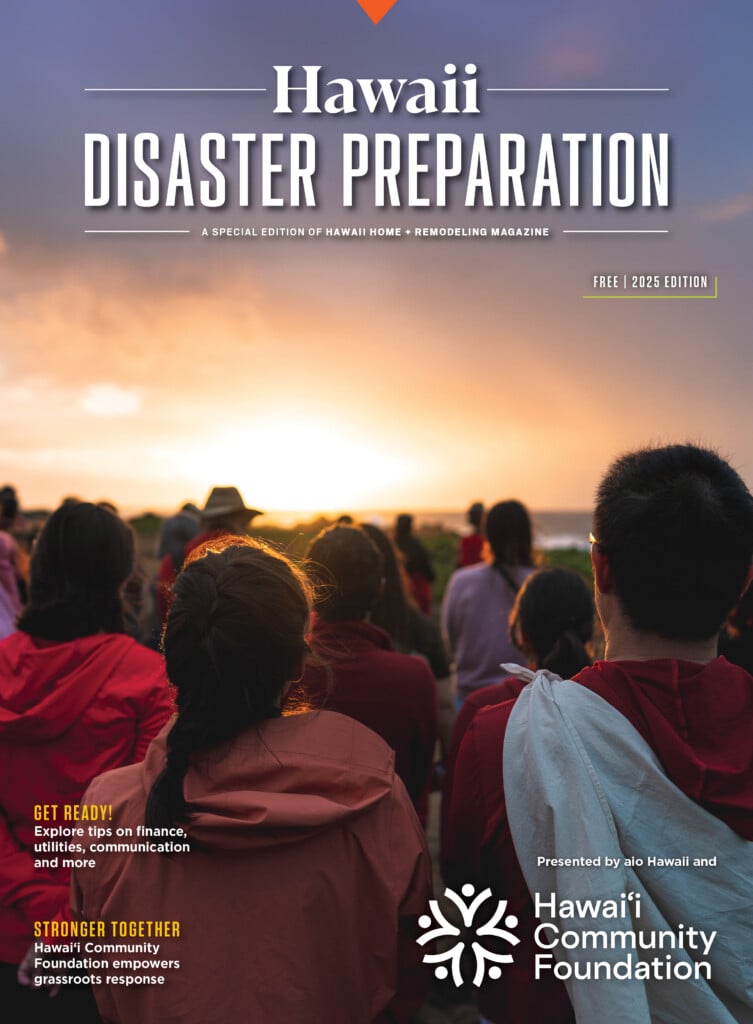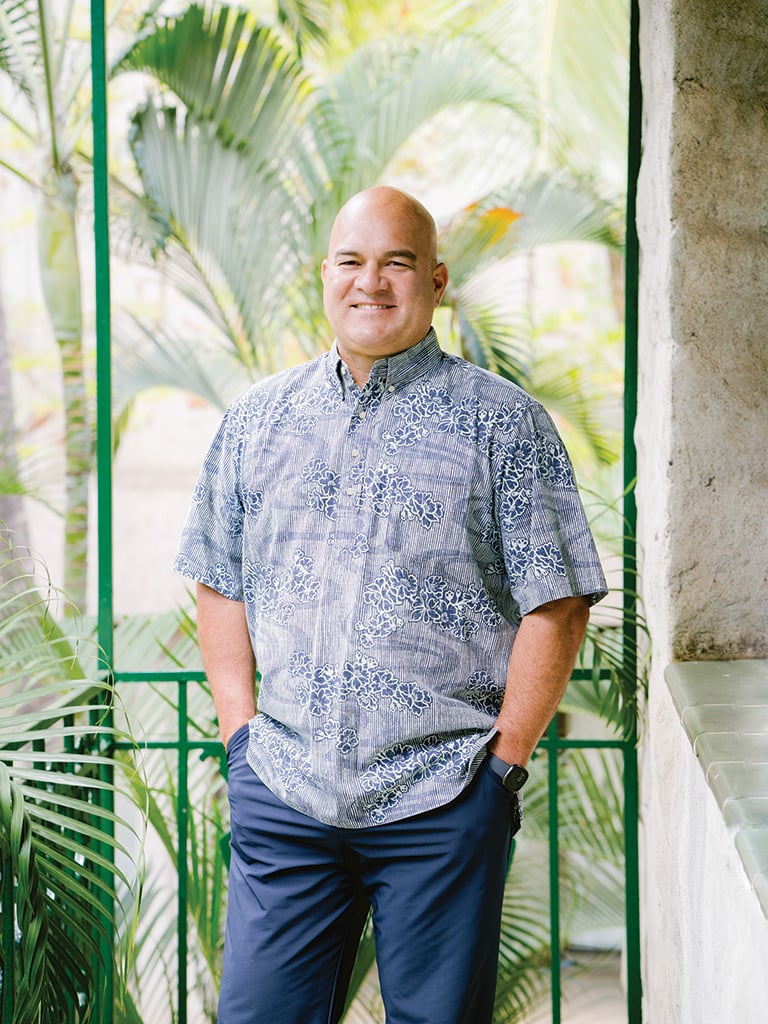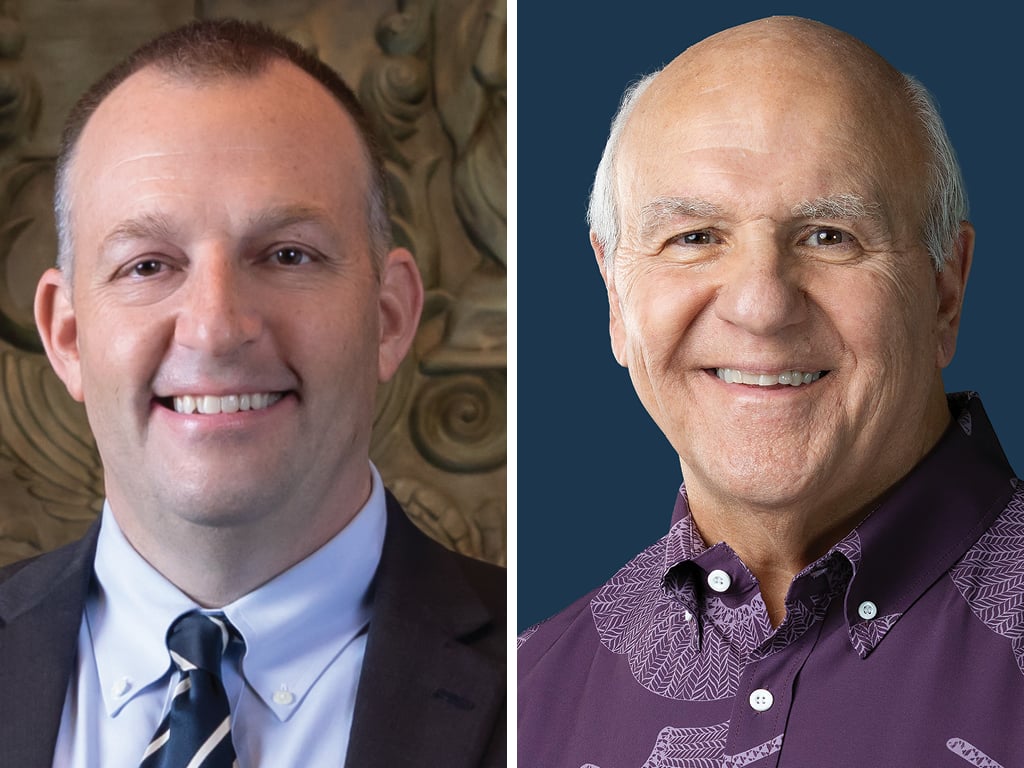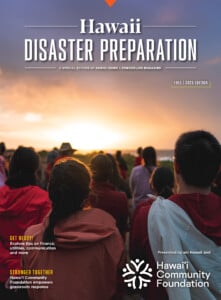Resilience in Action
Hawai‘i Community Foundation builds on lessons from Lahaina to support communities and place-based partnerships.
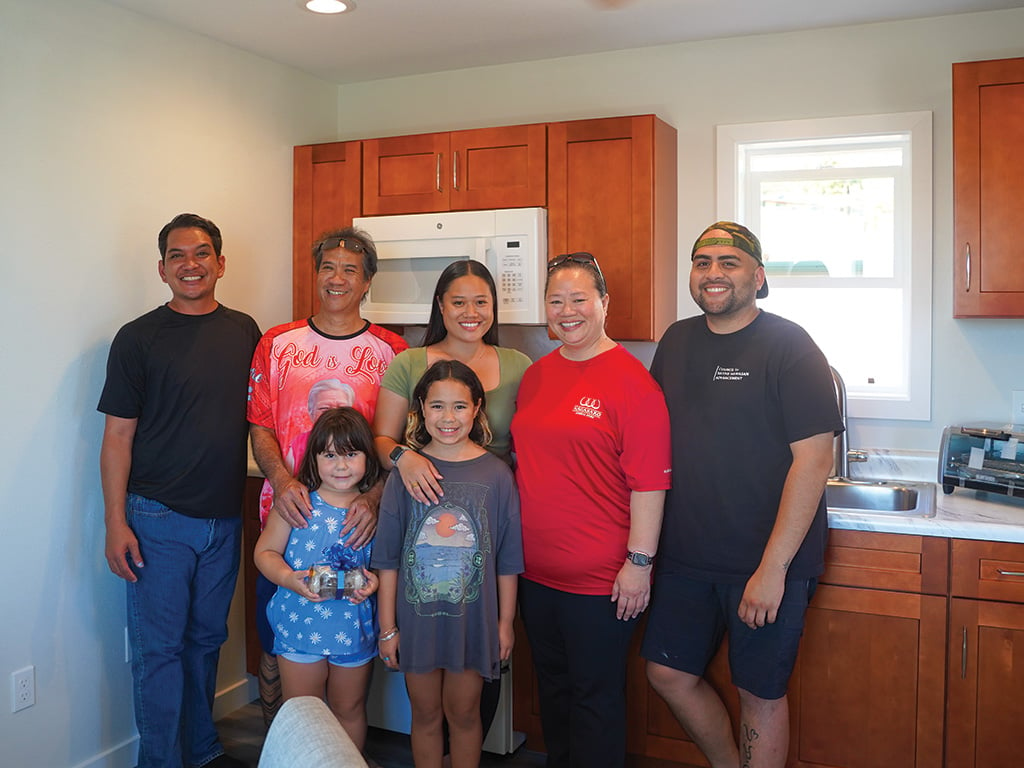
Featured photo: Members of the Ah Puck family were among the Lahaina fire survivors who moved into La‘ikū, a temporary housing community developed by HCF, CNHA and other partners. They are shown here with Dustin Kaleiopu (far right), CNHA community care navigator lead. (Photo courtesy of the Council for Native Hawaiian Advancement)
The spirit of lōkahi — a shared sense of purpose and unity — often reveals itself most powerfully in times of adversity. When wildfires struck Lahaina in 2023, the devastation was overwhelming. Yet in the aftermath, a wave of collective resolve rose from around the world to mālama those affected.
Keanu Lau Hee was in the situation room with Maui County officials after the fires. Now, as senior director of the Maui Recovery Effort at Hawai‘i Community Foundation (HCF), she draws on that firsthand experience to help align philanthropic support with community needs.
“Like so many others, I was profoundly moved by how our community came together in the face of unimaginable tragedy,” says Lau Hee. “The aloha that has carried us through these past months is a powerful reminder of our shared resilience, and it inspires me daily as we work together to rebuild and recover.”


Photos: Aaron K. Yoshino
Lau Hee leads grantmaking for HCF’s Maui Strong Fund. Since the Lahaina fires, HCF has worked closely with the County of Maui, as well as state and federal agencies, to identify key areas of support for survivors. HCF also launched the Maui Recovery Funders Collaborative to increase philanthropic impact.
“The scale of recovery will ultimately depend on sustained support from the government,” Lau Hee says, “but our team remains vigilant in assessing and responding to evolving needs.”
Recovery, she notes, is not short-term. “It will take years, and the needs — particularly for housing, mental health and economic stability — are far greater than any one organization can meet alone. As we move forward, we continue to use data to guide our decision-making, always asking: Where are the gaps, who remains underserved, and how can we work together to strengthen recovery?”
A Model of Partnership
HCF’s partnership with the Council for Native Hawaiian Advancement (CNHA) is an example of how cross-sector collaboration powerfully emerged after the Lahaina fires. With HCF’s strategic, data-informed funding and CNHA’s on-the-ground action and community networks, programs and resources were efficiently developed to prioritize and address Lahaina residents’ most pressing needs.
“These kinds of partnerships reduce duplication, streamline aid, and make it easier for families to navigate the help available to them,” says Kūhiō Lewis, CNHA CEO.
In the months after the disaster, CNHA launched the Host Housing Support Program, where Maui families took in ‘ohana and friends and received bedding, food and essentials. The Kāko‘o Maui Resource Hub also delivered “trusted, culturally grounded assistance,” says Lewis. HCF funding empowered CNHA to hire Maui-based staff to provide comfort and connection for survivors. Over time, HCF and CNHA developed temporary housing hubs as well.


The La‘ikū temporary housing project for Lahaina wildfire survivors consists of 16 two-bedroom, one-bath units located on land previously acquired by the Hawaii Department of Transportation on Lahainaluna Road. Furnishings and appliances were donated for each unit. Photos: Courtesy of the Council for Native Hawaiian Advancement
“With major support from HCF, 66 transitional housing units — 16 in Lahaina and 50 in Kahului — were developed to provide displaced families with safe and stable shelter,” says Lewis. “These homes are more than just a roof over their heads. They restore dignity, create a sense of security and help maintain the bonds of the community.”
Nearly two years after the fires, CNHA and HCF are focused on long-term recovery, including workforce development, financial empowerment, hazardous materials training and economic revitalization.
“We believe that economic strength is key to long-term stability,” says Lewis. “It supports everything from housing and healthcare to education and local infrastructure.”
Stronger Hawai‘i
Expanding on the Maui Strong blueprint, HCF’s Stronger Hawai‘i initiative strengthens connections across the state among services, disaster response resources and the communities they serve. Stronger Hawai‘i supports grassroots groups that provide emergency food assistance, housing, healthcare, recovery programs and more.
“Community-based response is essential because communities are always the first to feel the impacts of a disaster, and often the first to act,” says Kehau Meyer, senior program officer for the Maui Recovery Effort. “By investing in place-based capacity, we build long-term resilience rooted in trust and ‘āina-based expertise.”
On Hawai‘i Island, Vibrant Hawai‘i exemplifies this place-based approach. The nonprofit improves access to health and human services, supports economic growth, and plays a key role in disaster preparedness and response — with the culture and demographics of Hawai‘i Island residents in mind.
Another example of place-based collaboration is the hui of nonprofits that sprang into action after flooding on O‘ahu’s North Shore in 2021. HCF provided funding to support groups such as Hui o Hau‘ula, Lāhui Foundation, Waialua Community Association, and ‘ALE‘A Bridge as they quickly mobilized to provide food, supplies and emergency shelter.
“Ultimately, our role is to be a steady partner helping connect community-based efforts to broader systems, resources and funding streams,” says Meyer.
She outlines four key phases that guide HCF’s disaster and resilience funding strategies:
- Mitigation: Reducing disaster risk through planning, building codes and early warning systems.
- Preparedness: Strengthening readiness before disasters to enable faster, more effective response.
- Response: Providing immediate relief and restoring critical services after an emergency.
- Recovery: Supporting long-term rebuilding and helping communities bounce back stronger.
“We’re committed to building the kind of cross-sector coordination that ensures when the next emergency comes, communities are not only ready — they’re leading,” says Meyer.
Visit hawaiicommunityfoundation.org to learn more.

Photo: Courtesy of KEY Project
PARTNER PERSPECTIVE
Hawai‘i Community Foundation Grantee: Key Project
During the COVID-19 pandemic, KEY Project became a critical lifeline for Ko‘olau communities. We expanded food distribution along the coast, provided supplies, supported kūpuna through drive-up outreach, and helped residents access utility and rental assistance via the City and County of Honolulu. Flexible funding from HCF allowed us to respond to urgent needs while keeping our staff and facilities operational.
Past disasters revealed ongoing gaps in rural access to resources, community-appropriate communication, and coordinated response. KEY helps fill those gaps. Our rent and utility relief program also sparked a new workforce development effort that benefited the community for two years after the pandemic.
We continue to collaborate with local organizations, government agencies and residents before, during, and after emergencies. This includes resilience planning, coordinating the Ko‘olau Resilience Hub Network, serving as a distribution site, and providing post-disaster recovery support in partnership with Hawai‘i Foodbank. Vibrant Hawai‘i has been instrumental in supporting this hub coordination.
Our priority populations include kūpuna, Native Hawaiian families, low-income residents, and rural communities in Ko‘olaupoko and Ko‘olauloa — groups that often face the greatest barriers in times of crisis. That said, our doors are open to anyone in the Ko‘olau area.
A truly resilient Hawai‘i centers grassroots leadership, localized hubs, and cultural strengths. Every community deserves to prepare, respond, and recover with dignity and self-determination.
— Rainbow Uli‘i, KEY Project Executive Director
Hawai‘i Community Foundation is the title sponsor for the 2025 Hawaii Disaster Preparation Guide. View the digital edition of this issue here.



